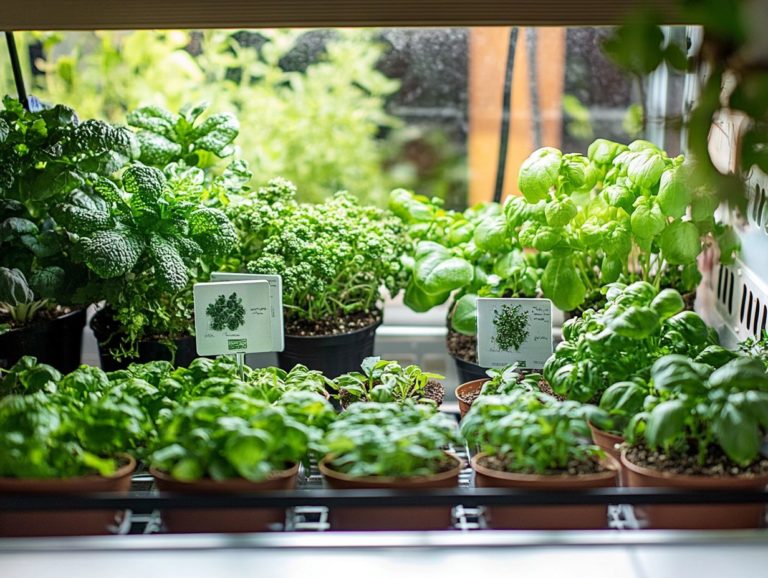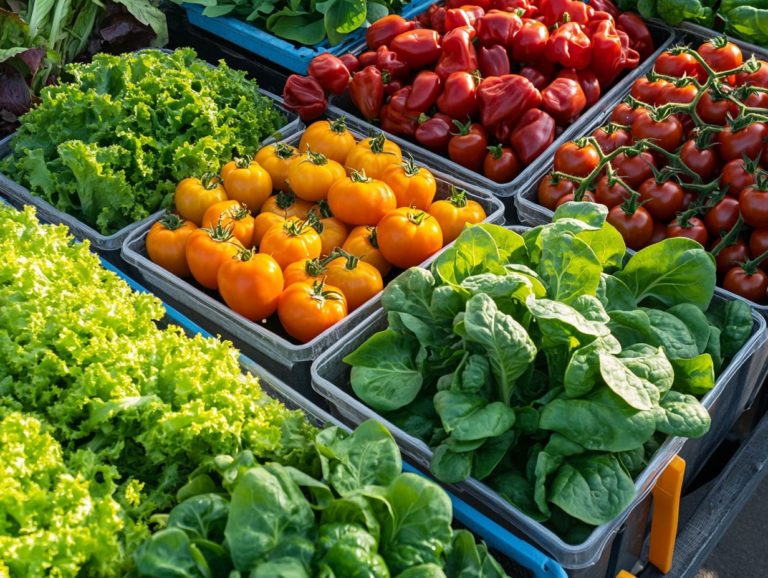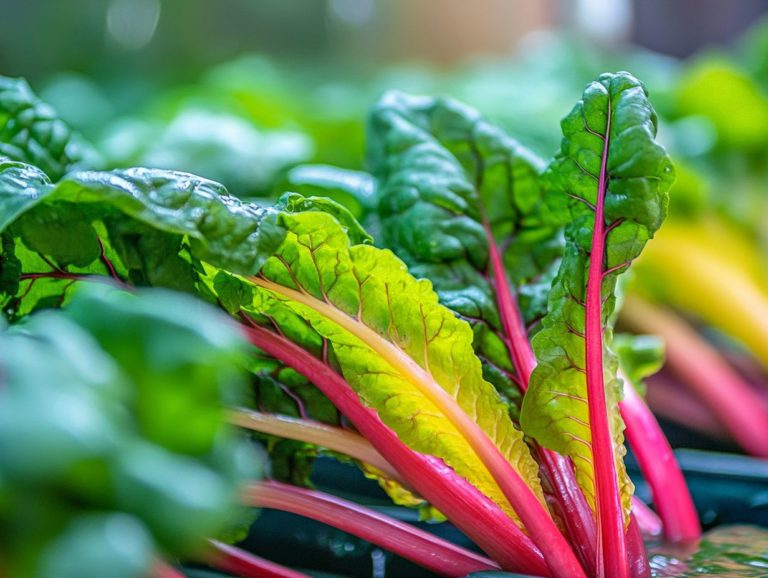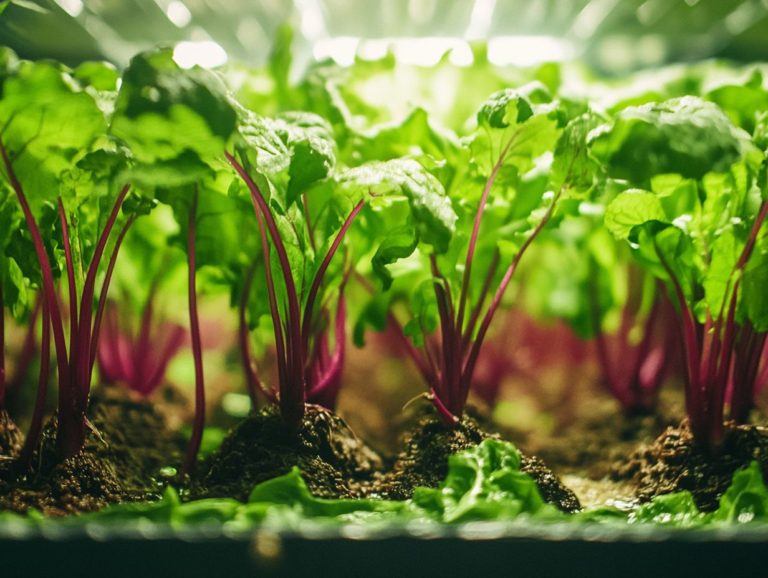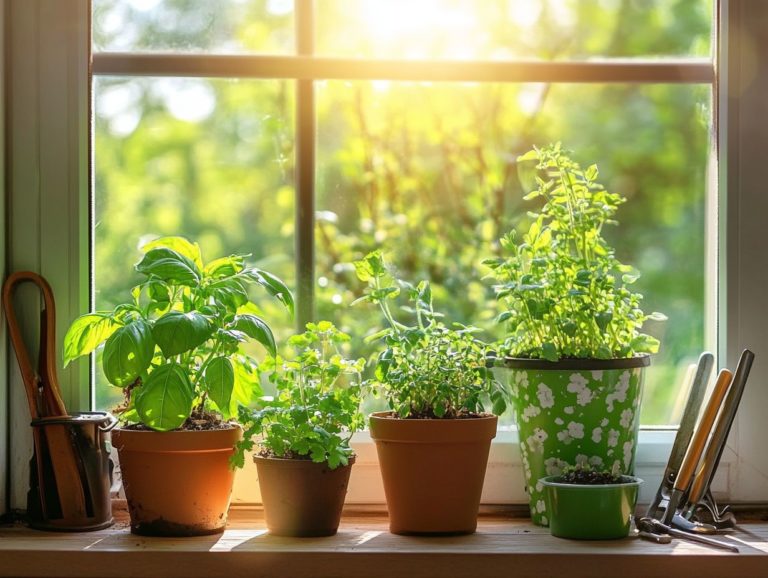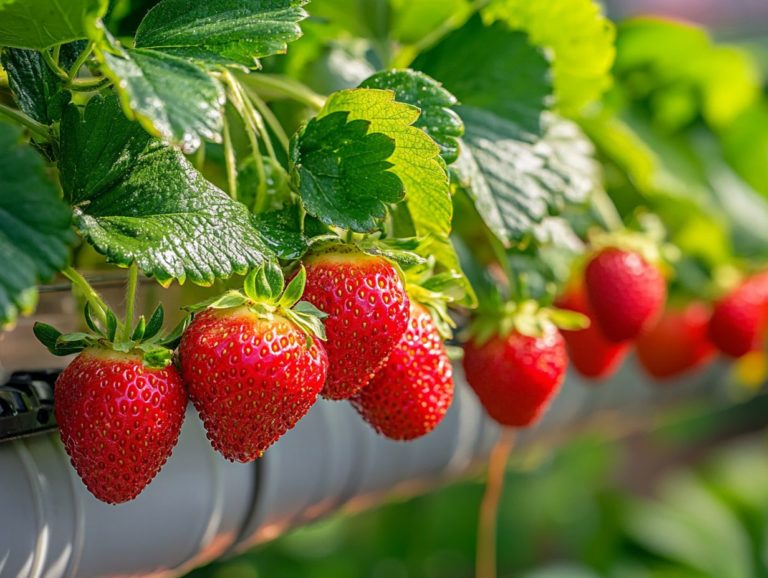“Choosing the Right Cucumber Variety for Hydroponics”
Hydroponic gardening has emerged as a favored method for cultivating many types of plants, including cucumbers, making them a versatile vegetable in modern agriculture.
This article will guide you through the advantages of growing cucumbers hydroponically. It will showcase how this method is more efficient than traditional soil-based techniques.
You ll explore essential factors to consider when selecting the ideal cucumber varieties, including their growth requirements, climate needs, and environmental factors.
We ll also highlight top cucumber varieties that flourish in hydroponic settings, including English, American, Japanese, and Persian cucumbers, providing you with practical tips to ensure a bountiful harvest.
Get ready to unlock the secrets to a bountiful cucumber harvest while understanding the health benefits of hydroponically grown crops!
Contents
- Key Takeaways:
- Benefits of Growing Cucumbers Hydroponically
- Factors to Consider When Choosing Cucumber Varieties
- Top Cucumber Varieties for Hydroponic Gardening
- Tips for Successful Hydroponic Cucumber Growth
- Frequently Asked Questions
- What are the benefits of choosing the right cucumber variety for hydroponics?
- What factors should I consider when choosing a cucumber variety for hydroponics?
- Are certain cucumber varieties more suitable for indoor hydroponics compared to outdoor hydroponics?
- How do I determine which cucumber variety is best for my hydroponic system?
- Can I grow multiple cucumber varieties in the same hydroponic system?
- Are there any cucumber varieties that are particularly well-suited for hydroponic growing?
Key Takeaways:
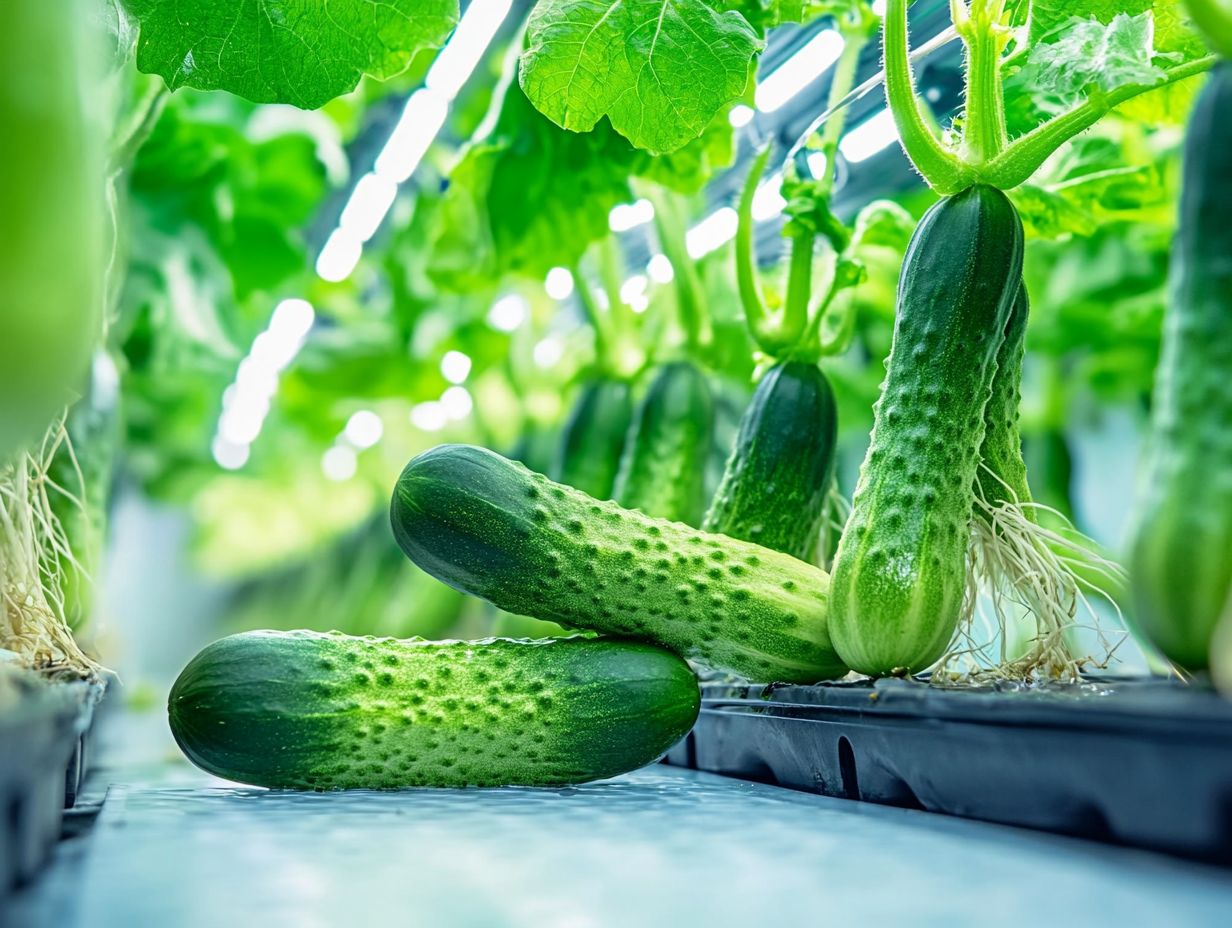
- Choose cucumber varieties that are suitable for hydroponic gardening, considering factors such as growth requirements, climate, and yield.
- Some top cucumber varieties for hydroponic gardening include English, Japanese, and Persian cucumbers, each with unique characteristics and benefits.
- Care for hydroponic cucumbers by maintaining nutrient levels and supporting vine growth.
What is Hydroponic Gardening?
Hydroponic gardening represents a cutting-edge approach to cultivating plants without the need for soil, utilizing solutions filled with nutrients to deliver essential minerals directly to the roots, ensuring optimal plant health.
This method gives you the power to create the best environments for growth, enabling precise control over critical factors such as nutrient concentration, pH levels, water levels, and water usage. By merging technology with horticulture, hydroponics allows you to grow a variety of crops think leafy vegetables and cucumbers both indoors and in urban settings, ensuring high-quality produce regardless of climate conditions, especially using systems like deep water culture and nutrient film technique.
The principles of hydroponics date back to ancient civilizations and have undergone significant evolution over the centuries. Early techniques demonstrated how plants could flourish without soil, relying solely on water and nutrients.
In comparison to traditional soil gardening, hydroponics significantly reduces water usage by recirculating nutrient solutions, positioning it as a more sustainable alternative that supports urban gardening. Noteworthy systems include deep water culture, where roots float in oxygen-rich nutrient solutions, and nutrient film technique, which allows a thin film of nutrients to flow over the roots, enhancing seed germination rates.
These innovative systems come with distinct advantages, such as accelerated plant growth and diminished disease risks, including effective pest control measures, positioning hydroponics as a vital strategy in the realm of modern agriculture.
Benefits of Growing Cucumbers Hydroponically
Growing cucumbers hydroponically presents a wealth of advantages over traditional cultivation methods, especially in terms of resource efficiency. You can expect increased crop yields, improved plant health, and significantly reduced issues with pests and diseases, as hydroponics allows for better disease prevention techniques.
This innovative approach grants you the ability to cultivate year-round, indifferent to external climate fluctuations, while allowing for precise control over critical environmental factors like nutrient concentration and water levels, thus enhancing the efficiency of indoor cultivation.
Hydroponic systems are very efficient, utilizing less water than conventional soil-based gardening, making them a sustainable choice for agriculture, especially in urban gardening setups.
Start your hydroponic journey today and enjoy fresh cucumbers year-round!
Advantages of Hydroponic Cucumbers over Soil-Grown Cucumbers
Hydroponic cucumbers offer a range of advantages over their soil-grown counterparts, mainly due to the control you have over the growth medium, nutrients that feed the plants, and environmental conditions. This ensures optimal health and growth. This method significantly lowers the risk of soil-borne diseases and simplifies maintenance tasks like pest control and pruning, allowing for a more streamlined growing experience. Hydroponic systems often lead to faster growth rates and superior-quality fruits, making them a top choice for many urban gardeners and commercial growers who appreciate the efficiency of hydroponic methods.
With precision in nutrient delivery, you ll be amazed at how your plants thrive when you give them exactly what they need for optimal health. This boosts their resilience against common pests and diseases through effective pest control strategies. This tailored approach maximizes growth efficiency while minimizing resource waste, making hydroponic cucumbers a more eco-friendly alternative to traditional soil methods and promoting sustainable practices in gardening.
While soil-grown varieties demand extensive weeding and constant irrigation monitoring, hydroponic systems provide a more streamlined experience. They allow for better air circulation and management, which is important because it helps prevent diseases by keeping the leaves dry. This focus enables you to achieve bountiful harvests with greater ease, especially when utilizing a trellis system for support.
Factors to Consider When Choosing Cucumber Varieties
Selecting the right cucumber variety is essential for success in hydroponic gardening. It demands thoughtful consideration of several factors, such as growth habits and whether they are self-pollinating. Evaluate climate requirements and the overall yield impacted by the growth habits of the varieties.
Each cucumber type be it English, American, Japanese, or Persian has unique characteristics that can significantly influence their growth and yield. Choosing quality seeds is crucial for success. By understanding these nuances, you can make informed choices about quality seeds that are ideally suited for your indoor cultivation systems, ensuring a successful growing experience.
Growth Requirements of Cucumbers
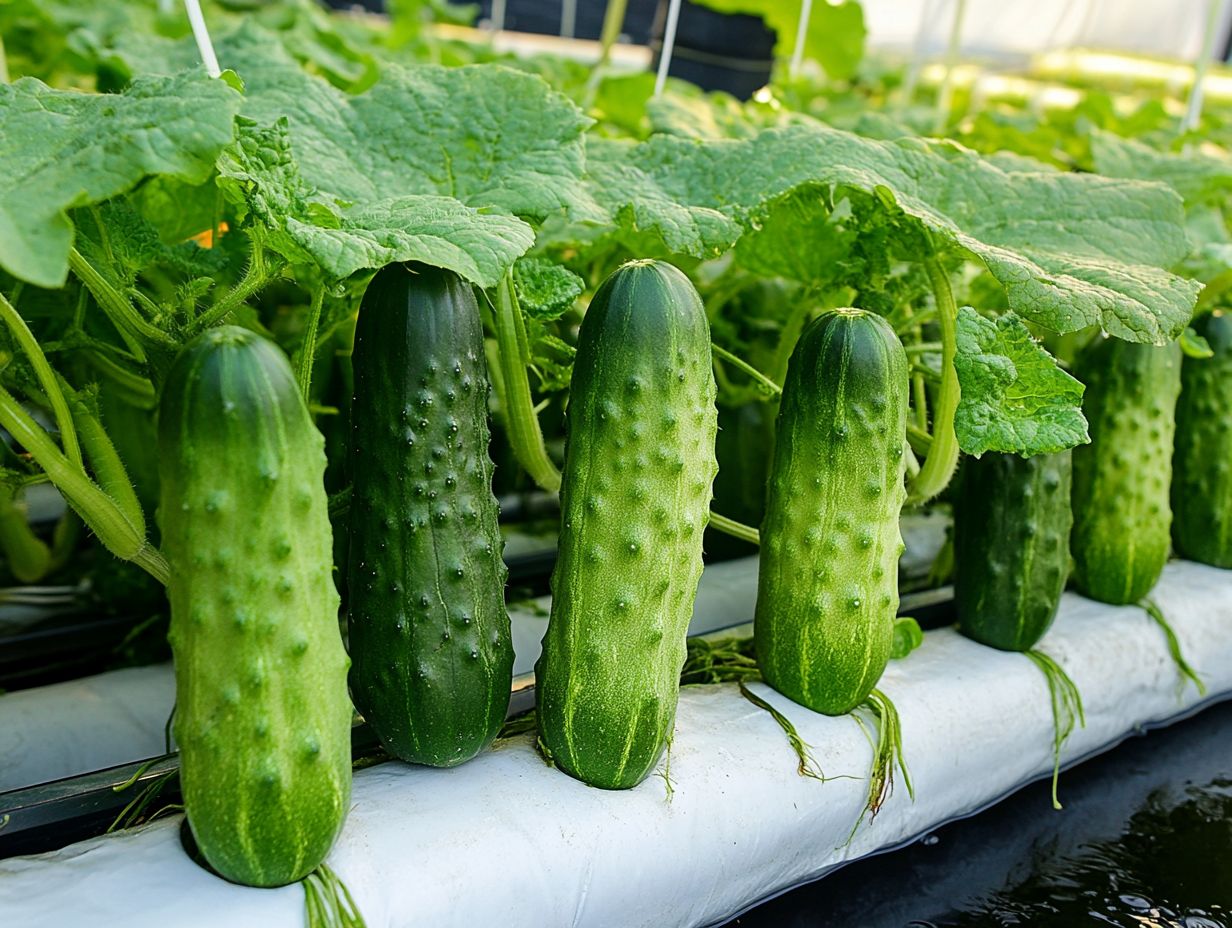
Cucumber plants have specific growth requirements that you need to meet to ensure they thrive in hydroponic systems. This includes selecting the right growth medium, maintaining suitable nutrient concentrations, and establishing appropriate light cycles for successful seed germination. Remember, air circulation, temperature, and humidity are also crucial for healthy plant development, especially when using automated humidity monitors and temperature control systems.
By keeping these environmental conditions consistent and adjusting as necessary, you can maximize cucumber production and cultivate vibrant, healthy cucumber plants.
To encourage strong growth, choose a growth medium that retains moisture while allowing for proper drainage. This helps prevent root rot through effective water management. Nutrient solutions should be tailored to the developmental stage of your cucumber plants, ensuring they receive an adequate supply of nitrogen, phosphorus, potassium, and trace minerals for optimal health.
Maintaining a consistent light cycle of 14-16 hours per day stimulates flowering and fruiting. Keeping temperatures between 65-75 F promotes robust growth, which is essential for effective harvesting. Regularly checking humidity levels, ideally between 50-70%, will help you avoid diseases like powdery mildew and other fungal issues that can affect plant health.
Regularly monitor these factors to create the best environment for your cucumbers to thrive and achieve high-quality fruit. Don t wait start monitoring these factors today to ensure your cucumbers grow healthy and strong!
Climate and Environment
Understanding climate requirements is crucial for cultivating cucumbers in hydroponics. This is especially true for indoor gardening where lighting is key.
Factors like water levels and humidity greatly influence cucumber growth. Replicating ideal conditions ensures plants thrive.
Cucumbers do best in temperatures between 70 F and 85 F. This supports efficient photosynthesis and growth rates.
Maintain humidity levels between 60% and 70%. Too much moisture can lead to fungal issues, while dryness can stunt growth.
Manage water levels carefully. Consistent moisture prevents stress and improves yield, which you can monitor with pH testing.
Make environmental adjustments like temperature control and automated humidity monitors. This will elevate your cucumber cultivation.
Harvest and Yield
Harvesting cucumbers at the right moment maximizes yield and flavor. Regularly check your plants to find the optimal size for harvesting.
Familiarize yourself with the signs of ripeness. Look for vibrant color and firmness to ensure peak quality.
Timing is key; late harvesting can lead to overripe fruits that hinder growth. Understanding the light cycle helps with this.
Implement pest control strategies with regular inspections and organic repellents. This prevents infestations and maintains plant health.
Proper spacing and watering techniques nurture healthier plants. This ultimately leads to a bountiful harvest.
Top Cucumber Varieties for Hydroponic Gardening
Your choice of cucumber varieties can greatly influence your success. Consider English cucumbers, Persian cucumbers, and gherkins.
Each variety has unique characteristics suited to different tastes. Understanding these nuances helps optimize your hydroponic system.
Descriptions and Characteristics of Each Variety
Each cucumber variety has its own traits. These traits cater to various culinary uses and gardening preferences.
The English cucumber is sleek and sweet. It adds a refreshing crunch to salads and enhances cold soups.
American cucumbers are known for their robust texture, often ending up in dill pickles that complement sandwiches.
Japanese cucumbers have thin skin and delightful sweetness, perfect for sushi rolls. Gherkins bring vibrant tartness to any dish.
Tips for Successful Hydroponic Cucumber Growth
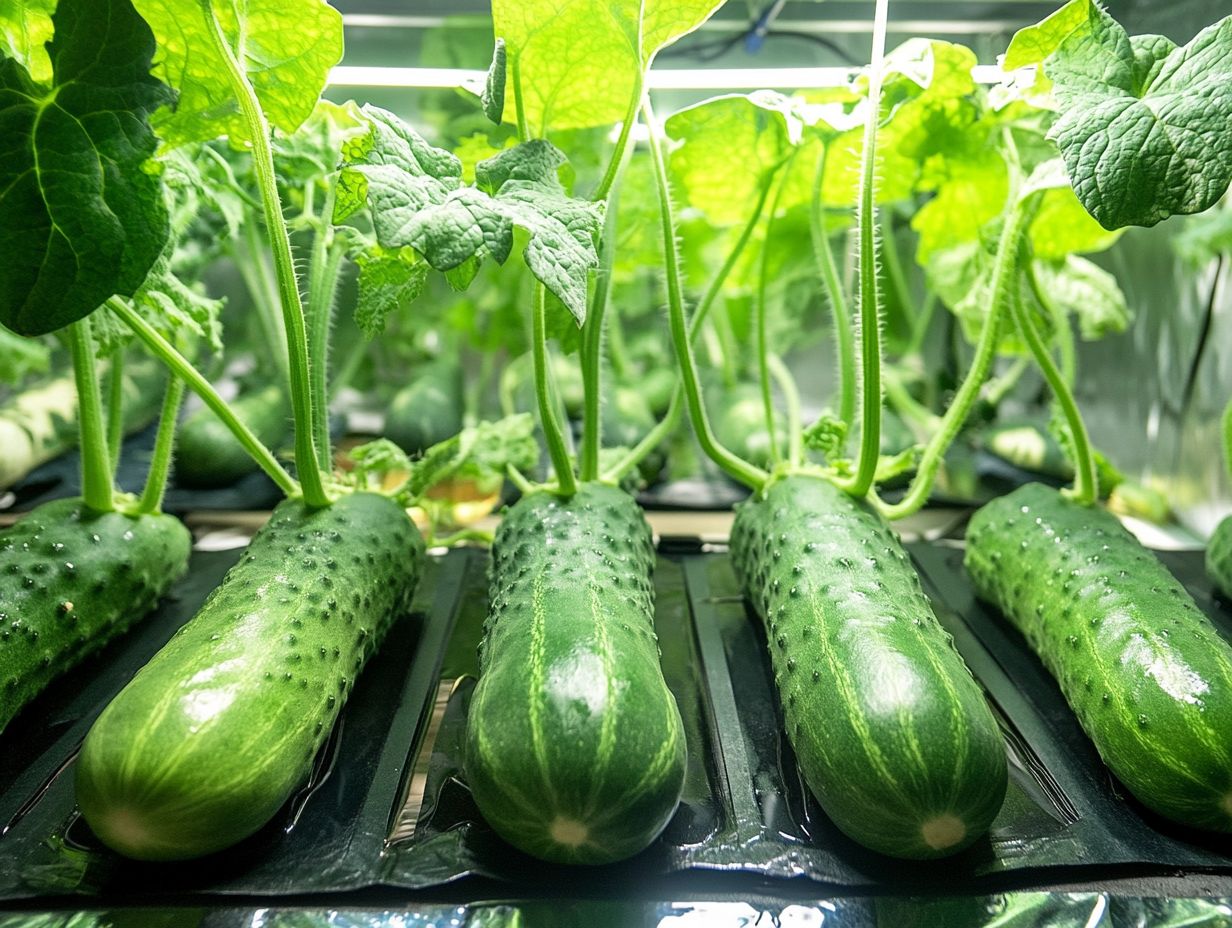
To achieve successful hydroponic cucumber growth, you ll want to embrace a blend of best practices. This includes care instructions that pay attention to detail, consistent maintenance routines, and effective pest control strategies.
By implementing these approaches, you can significantly enhance plant health and yield while effectively minimizing the common challenges that may surface in hydroponics.
Gaining a deep understanding of the specific needs of cucumber plants will elevate your efforts, paving the way for the cultivation of delicious, high-quality fruits.
Best Practices for Caring for Hydroponic Cucumbers
To achieve the finest results in hydroponic cucumber gardening, it’s crucial to embrace best practices like careful management of nutrients, strategic lighting control, and timely pruning.
A well-balanced nutrient solution is your foundation for optimal growth. Effective lighting enhances photosynthesis the process plants use to turn light into food and promotes overall plant health. Regular pruning maintains your plant’s structure. It also encourages a more fruitful yield.
Cultivating hydroponic cucumbers is an exquisite blend of science and artistry, beginning with a nutrient-rich solution tailored specifically for cucumbers. This solution should be infused with essential elements like nitrogen, phosphorus, and potassium.
Equally important is your lighting strategy. Ensure your plants bask in approximately 12 to 16 hours of light daily from a spectrum that nurtures growth without inducing stress.
Incorporating pruning techniques, such as removing yellowing leaves and pinching back excess growth, enhances airflow and directs the plant’s energy toward fruit development. This ultimately leads to a more abundant harvest.
Mastering these elements will elevate your yield and enhance the overall vigor of your plants.
Final Thoughts and Recommendations for Choosing the Right Cucumber Variety for Hydroponics
Choosing the right cucumber variety for hydroponics is crucial for ensuring your plants thrive and maximizing your yield. Opt for quality seeds that align with your specific growing conditions.
Understanding the unique traits of each variety can make your gardening experience even more rewarding! Prioritize selections that flourish in nutrient-rich solutions and demonstrate robust growth rates and impressive productivity.
It’s essential to assess each variety’s resilience against common pests and diseases, ensuring your plants maintain their health throughout their lifecycle. The right choices will adapt seamlessly to the controlled environment of hydroponics, resulting in more consistent harvests.
By considering these factors, you’ll be well on your way to enjoying a plentiful cucumber crop that excels in both taste and quality.
Act now to ensure your cucumbers thrive!
Frequently Asked Questions
What are the benefits of choosing the right cucumber variety for hydroponics?
Choosing the right cucumber variety for hydroponics can result in higher yields, better quality produce, and a more efficient use of resources.
What factors should I consider when choosing a cucumber variety for hydroponics?
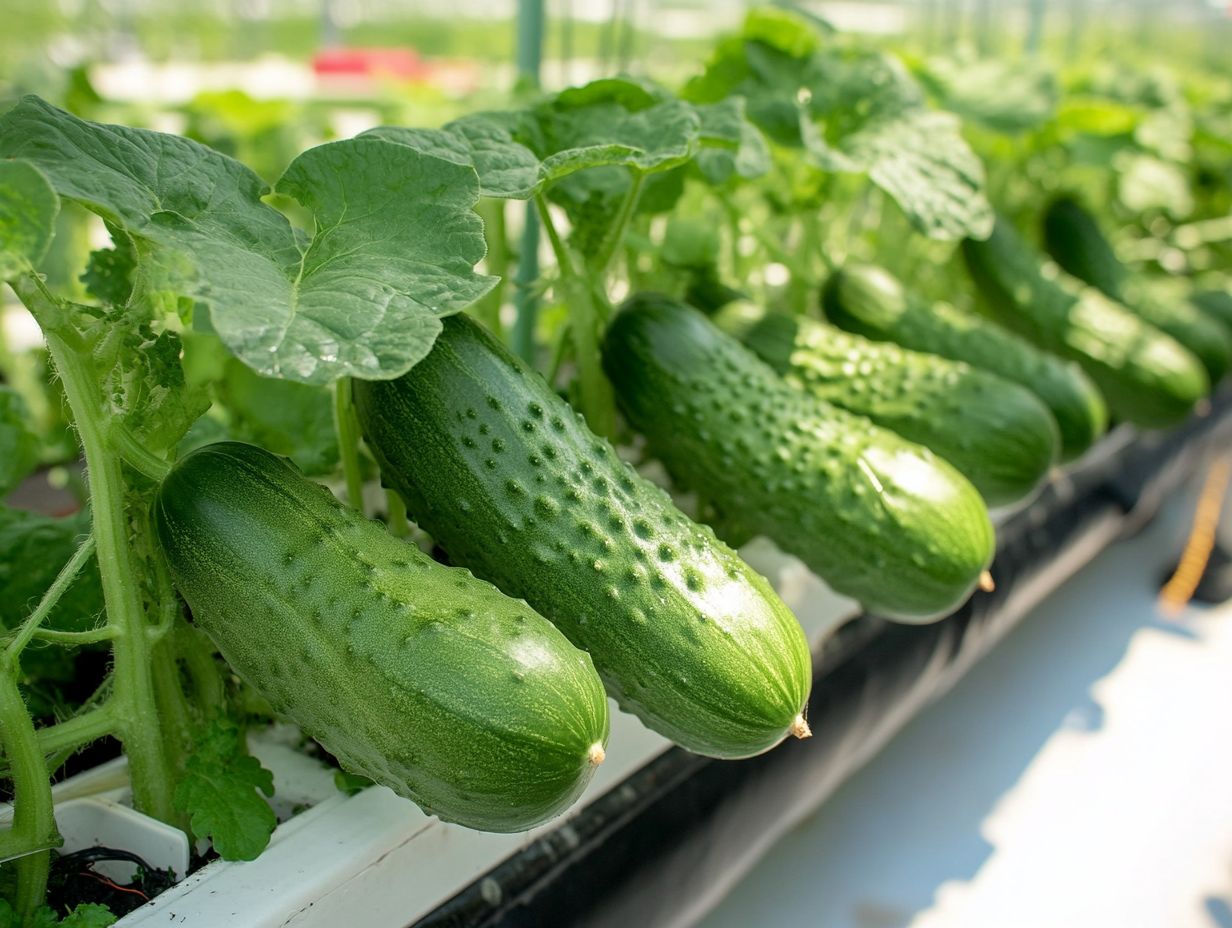
Some important factors to consider are:
- Growth habit
- Disease resistance
- Fruit size
- Overall suitability for hydroponic growing conditions
Are certain cucumber varieties more suitable for indoor hydroponics compared to outdoor hydroponics?
Yes, some cucumber varieties are better suited for indoor hydroponics due to their compact growth habit and lower light requirements.
How do I determine which cucumber variety is best for my hydroponic system?
Consider your specific hydroponic setup and growing environment. Research which cucumber varieties perform well under those conditions. You can also consult with experienced hydroponic farmers for recommendations.
Can I grow multiple cucumber varieties in the same hydroponic system?
Yes, you can grow multiple cucumber varieties in the same hydroponic system. Just ensure they have similar growing needs and compatible spacing.
Are there any cucumber varieties that are particularly well-suited for hydroponic growing?
Yes! Some cucumber varieties are perfect for hydroponics. Popular choices include Marketmore, Bush Champion, and Straight Eight.

